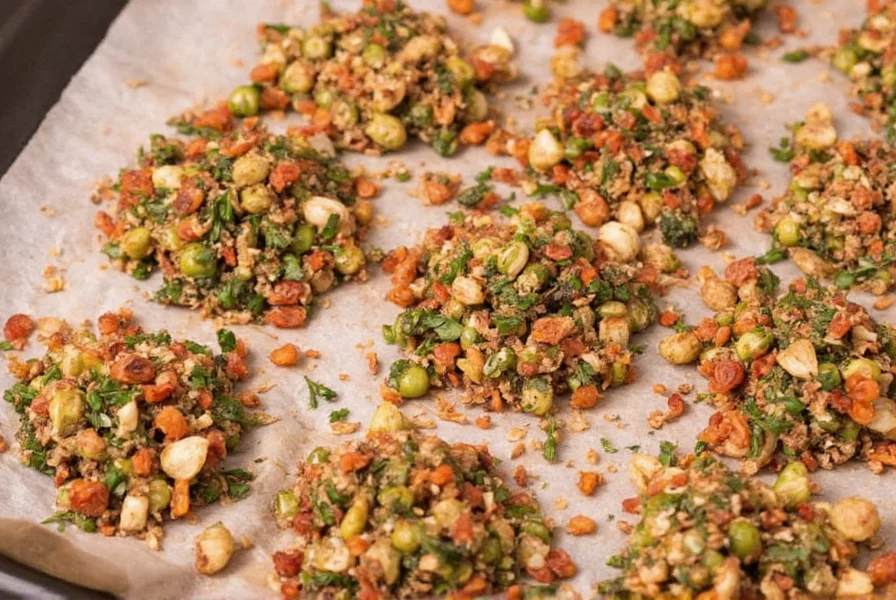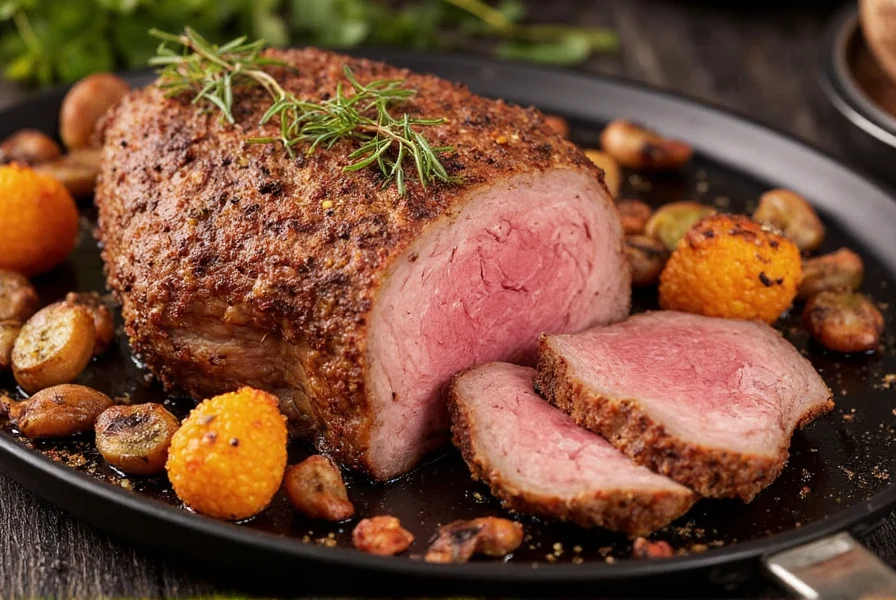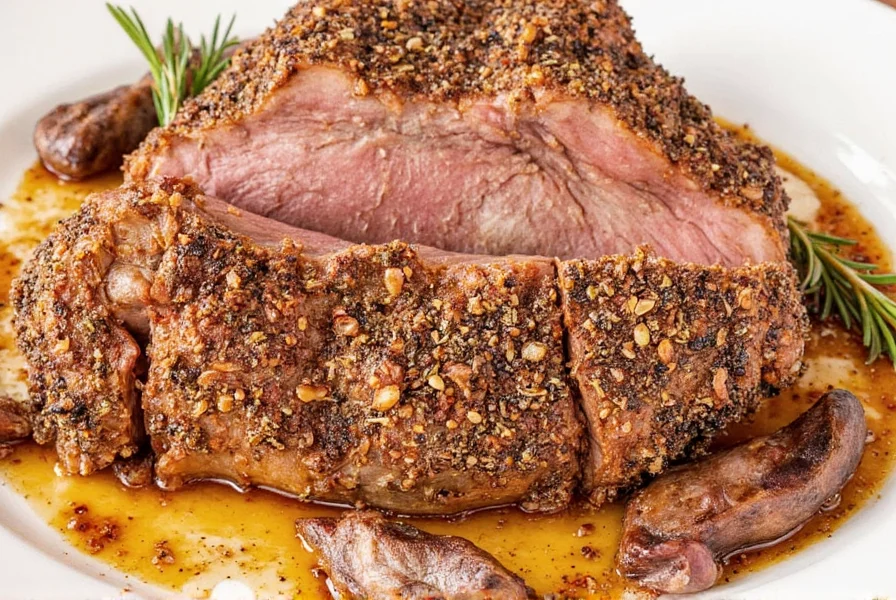The best all-purpose roast seasoning blend combines 1 teaspoon kosher salt, ½ teaspoon freshly ground black pepper, ½ teaspoon garlic powder, ½ teaspoon onion powder, and ¼ teaspoon dried thyme or rosemary per pound of meat. For beef roasts, add ¼ teaspoon smoked paprika; for pork, include ¼ teaspoon rubbed sage; for lamb, incorporate ¼ teaspoon dried mint; and for poultry, add lemon zest. Always season at least 45 minutes before cooking—ideally dry-brining overnight—for optimal flavor penetration and crust development.
Seasoning a roast properly transforms an ordinary cut of meat into a memorable meal. While the basic formula remains consistent across meat types, understanding how different seasonings interact with specific proteins elevates your cooking from good to exceptional. This guide provides professional insights that go beyond simple ingredient lists, explaining the why behind effective seasoning combinations for various roasts.
Understanding Roast Types and Their Seasoning Needs
Not all roasts respond to seasoning in the same way. Each meat type has unique fat content, muscle structure, and flavor compounds that determine optimal seasoning approaches.
Beef roasts like ribeye, sirloin, or chuck benefit from robust seasonings that complement their rich, meaty flavor. The high fat content carries fat-soluble flavor compounds, making ingredients like garlic, rosemary, and black pepper particularly effective.
Pork roasts require a more delicate balance. Their mild flavor profile can be overwhelmed by aggressive seasonings. Sage, thyme, and subtle sweetness from ingredients like brown sugar or apple cider enhance rather than mask pork's natural taste.
Lamb roasts possess distinctive earthy notes that pair beautifully with Mediterranean herbs. Mint, oregano, and rosemary create classic combinations that harmonize with lamb's unique flavor profile without overpowering it.
Poultry roasts need seasoning that penetrates the skin to flavor the meat beneath. Lemon zest, garlic, and poultry-specific herb blends work exceptionally well when applied under the skin or through dry brining.

Essential Seasoning Components for Perfect Roast
Creating the perfect roast seasoning isn't just about throwing random spices together. Each component serves a specific purpose in flavor development:
| Seasoning Component | Function | Best Application Timing |
|---|---|---|
| Kosher salt | Breaks down proteins, enhances natural flavors, creates crust | At least 45 minutes before cooking (overnight dry brine ideal) |
| Freshly ground black pepper | Adds complexity and subtle heat | Immediately before cooking |
| Dried herbs (thyme, rosemary) | Provides earthy, aromatic notes | Mixed with salt for dry brine or applied before cooking |
| Garlic and onion powder | Creates savory umami foundation | Combined with salt for dry brine |
| Fresh herbs | Adds bright, complex top notes | Added during last 30 minutes of cooking |
Classic Roast Seasoning Blends by Meat Type
While the all-purpose blend works well for most situations, these specialized combinations deliver restaurant-quality results for specific meats:
Traditional Beef Roast Seasoning
Combine 1 tsp kosher salt, ½ tsp freshly ground black pepper, ½ tsp garlic powder, ¼ tsp onion powder, ¼ tsp dried thyme, and ¼ tsp smoked paprika per pound of meat. For special occasions, add 1 tsp Dijon mustard to create a paste that locks in moisture while developing complex flavors during cooking.
Perfect Pork Roast Rub
Mix 1 tsp kosher salt, ½ tsp freshly ground black pepper, ½ tsp garlic powder, ¼ tsp rubbed sage, ¼ tsp dried thyme, and a pinch of brown sugar per pound. The sugar caramelizes during cooking, creating an irresistible crust without overpowering the pork's delicate flavor.
Elegant Lamb Roast Combination
Blend 1 tsp kosher salt, ½ tsp freshly ground black pepper, ½ tsp garlic powder, ¼ tsp dried mint, ¼ tsp dried oregano, and ¼ tsp dried rosemary per pound. For an authentic Mediterranean touch, add 1 tablespoon chopped fresh mint and 1 minced garlic clove under the fat cap before cooking.
Simple Poultry Roast Seasoning
Combine 1 tsp kosher salt, ½ tsp freshly ground black pepper, ½ tsp garlic powder, ¼ tsp poultry seasoning, and the zest of ½ lemon per pound. For deeper flavor penetration, gently loosen the skin and apply half the mixture directly to the meat.

Advanced Seasoning Techniques for Professional Results
Professional chefs use specific techniques to maximize flavor development in roasts. Understanding these methods transforms good seasoning into exceptional results.
Dry brining versus immediate seasoning makes a significant difference in final results. Dry brining (applying salt 12-24 hours before cooking) allows salt to penetrate deeper into the meat, seasoning it throughout rather than just on the surface. The salt initially draws out moisture, which then dissolves the salt and is reabsorbed into the meat, carrying seasoning with it.
Layering flavors creates complexity that single-application seasoning cannot match. Start with a dry brine of salt and dried herbs 24 hours before cooking. Just before roasting, add freshly ground pepper and additional dried spices. During the final 30 minutes of cooking, add fresh herbs directly to the pan for aromatic top notes.
Timing seasoning applications properly ensures optimal flavor development. Salt benefits from early application, while delicate ingredients like fresh herbs and citrus zest should be added later in the cooking process to preserve their volatile flavor compounds.
Dietary Considerations and Seasoning Alternatives
Special dietary needs shouldn't compromise roast flavor. These alternatives maintain delicious results while accommodating restrictions:
- Low-sodium options: Replace half the salt with celery seed, lemon zest, or mushroom powder for umami depth without excess sodium
- Gluten-free considerations: Most basic seasonings are naturally gluten-free, but check spice blends for hidden fillers
- Allergen-friendly substitutions: Replace garlic with asafoetida (hing) for similar savory notes without the allergen
- Fresh herb alternatives: When specific fresh herbs are unavailable, use ⅓ the amount of dried herbs (dried herbs are more concentrated)
Common Seasoning Mistakes to Avoid
Even experienced cooks make these seasoning errors that compromise roast quality:
- Seasoning too late: Applying salt less than 45 minutes before cooking creates a wet surface that steams rather than sears
- Over-reliance on pre-made blends: Commercial seasoning mixes often contain excessive salt and fillers that don't create optimal flavor balance
- Ignoring meat temperature: Seasoning frozen or very cold meat prevents proper adhesion and flavor penetration
- Mixing incompatible flavors: Strong competing flavors like cumin and mint create confusion rather than harmony in the finished dish
Perfecting Your Roast Seasoning Technique
Mastering roast seasoning requires understanding both the science and art of flavor development. The right combination of salt, aromatics, and complementary spices transforms ordinary meat into extraordinary meals. Remember that seasoning isn't just about applying spices—it's about creating flavor layers that develop throughout the cooking process.
For best results, always start with quality meat, apply proper seasoning techniques based on the specific roast type, and allow adequate time for flavors to develop. Whether you're preparing a simple weeknight roast or a special occasion centerpiece, these seasoning principles ensure consistently delicious results that impress family and guests alike.











 浙公网安备
33010002000092号
浙公网安备
33010002000092号 浙B2-20120091-4
浙B2-20120091-4